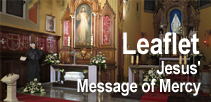Out of all the forms of devotion to Divine Mercy given by Sister Faustina, the Hour of Mercy was the last one to be discovered and popularized, since the first publications associated with this devotion concentrated on popularizing the Chaplet, Novena and Litany. It was not until the writings of St. Sister Faustina, especially her Diary, were subjected to theological analysis by Father Prof. I. Różycki for her beatification process, that those prayers revealed by the Lord Jesus, and favoured by Him with special promises for all those who practise them, were selected from among the many recorded. Alongside the veneration of the image of Merciful Jesus, celebrations of the Feast of The Divine Mercy, reciting the Chaplet of Divine Mercy, and spreading the devotion to Mercy, the Hour of Mercy is one of the newer and most popular forms of the devotion. Following publication of the works of Father Różycki on the devotion to Divine Mercy, this form of devotion developed fairly rapidly. Practising this devotion does not require any special circumstances (e.g. church attendance) but only to connect (at three o’clock) with Jesus dying on the cross, wherever we happen to be at this time, to reflect on His Passion, and to refer to its value and merit in our supplications.
















